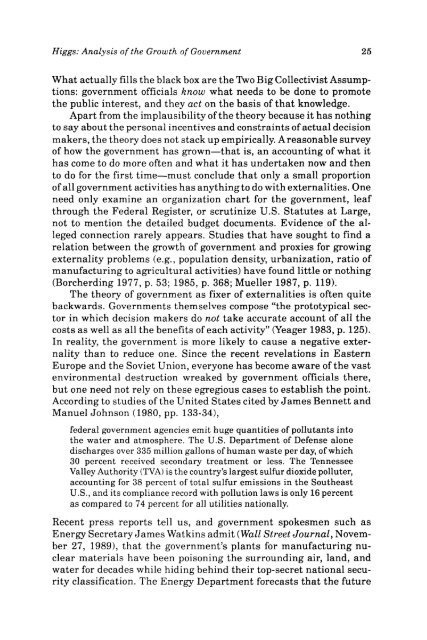Review of Austrian Economics - The Ludwig von Mises Institute
Review of Austrian Economics - The Ludwig von Mises Institute
Review of Austrian Economics - The Ludwig von Mises Institute
You also want an ePaper? Increase the reach of your titles
YUMPU automatically turns print PDFs into web optimized ePapers that Google loves.
Higgs: Analysis <strong>of</strong> the Growth <strong>of</strong> Government 25<br />
What actually fills the black box are the Two Big Collectivist Assumptions:<br />
government <strong>of</strong>ficials know what needs to be done to promote<br />
the public interest, and they act on the basis <strong>of</strong> that knowledge.<br />
Apart from the implausibility <strong>of</strong> the theory because it has nothing<br />
to say about the personal incentives and constraints <strong>of</strong> actual decision<br />
makers, the theory does not stack up empirically. A reasonable survey<br />
<strong>of</strong> how the government has grown—that is, an accounting <strong>of</strong> what it<br />
has come to do more <strong>of</strong>ten and what it has undertaken now and then<br />
to do for the first time—must conclude that only a small proportion<br />
<strong>of</strong> all government activities has anything to do with externalities. One<br />
need only examine an organization chart for the government, leaf<br />
through the Federal Register, or scrutinize U.S. Statutes at Large,<br />
not to mention the detailed budget documents. Evidence <strong>of</strong> the alleged<br />
connection rarely appears. Studies that have sought to find a<br />
relation between the growth <strong>of</strong> government and proxies for growing<br />
externality problems (e.g., population density, urbanization, ratio <strong>of</strong><br />
manufacturing to agricultural activities) have found little or nothing<br />
(Borcherding 1977, p. 53; 1985, p. 368; Mueller 1987, p. 119).<br />
<strong>The</strong> theory <strong>of</strong> government as fixer <strong>of</strong> externalities is <strong>of</strong>ten quite<br />
backwards. Governments themselves compose "the prototypical sector<br />
in which decision makers do not take accurate account <strong>of</strong> all the<br />
costs as well as all the benefits <strong>of</strong> each activity" (Yeager 1983, p. 125).<br />
In reality, the government is more likely to cause a negative externality<br />
than to reduce one. Since the recent revelations in Eastern<br />
Europe and the Soviet Union, everyone has become aware <strong>of</strong> the vast<br />
environmental destruction wreaked by government <strong>of</strong>ficials there,<br />
but one need not rely on these egregious cases to establish the point.<br />
According to studies <strong>of</strong> the United States cited by James Bennett and<br />
Manuel Johnson (1980, pp. 133-34),<br />
federal government agencies emit huge quantities <strong>of</strong> pollutants into<br />
the water and atmosphere. <strong>The</strong> U.S. Department <strong>of</strong> Defense alone<br />
discharges over 335 million gallons <strong>of</strong> human waste per day, <strong>of</strong> which<br />
30 percent received secondary treatment or less. <strong>The</strong> Tennessee<br />
Valley Authority (TVA) is the country's largest sulfur dioxide polluter,<br />
accounting for 38 percent <strong>of</strong> total sulfur emissions in the Southeast<br />
U.S., and its compliance record with pollution laws is only 16 percent<br />
as compared to 74 percent for all utilities nationally.<br />
Recent press reports tell us, and government spokesmen such as<br />
Energy Secretary James Watkins admit (Wall Street Journal, November<br />
27, 1989), that the government's plants for manufacturing nuclear<br />
materials have been poisoning the surrounding air, land, and<br />
water for decades while hiding behind their top-secret national security<br />
classification. <strong>The</strong> Energy Department forecasts that the future

















